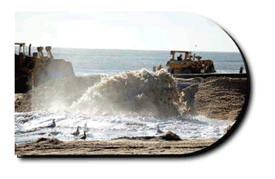Facts About Shore Protect Team Uncovered
The Only Guide to Shore Protect Team
Table of ContentsThe 2-Minute Rule for Shore Protect TeamA Biased View of Shore Protect TeamGetting My Shore Protect Team To WorkFascination About Shore Protect TeamSome Of Shore Protect TeamShore Protect Team - An OverviewThe Ultimate Guide To Shore Protect Team
Decrease in property value: As the area tourist is affected by disintegration, so then is the economy. Buyers are much less most likely to look for a beach home that could be ruined anytime by the upcoming flooding and erosion emergency situation. Consequently, home worth can drop profoundly and affect the entire area.Whether a beach is simply small and crowded or needs to close entirely for the security of the community and nearby residential properties, this substantially influences tourism. Consequently, regional economic climates are affected (https://yamap.com/users/4884831). Danger of injury: The enhanced risk of flooding and structural failings triggers a boosted threat of injury to neighboring tourists and area members

Shoreline stablizing is straight associated to their job. Waterside resorts: Since coastline erosion influences tourist, it influences the success of beachfront resorts.
6 Easy Facts About Shore Protect Team Explained
Coastal commercial organizations: No visitors suggests no service. Coastal state parks: State parks that exist along coasts are at danger of damages.
Soft stabilization is a better option for the environment and even more sustainable overall. Hard stablizing utilizes man-made frameworks as protection to control erosion. Typically, these structures are set up at ideal angles or alongside stop sand activity and reduce the pressure of waves. A lot of forms of tough stablizing like seawalls and sheet steel are not excellent for coastline stabilization.
6 Easy Facts About Shore Protect Team Explained
There's likewise not sufficient evidence of their effectiveness depending on the sort of shoreline and neighborhood conditions. Tough stabilization strategies tend to be extra challenging to install and do not match the all-natural visual, protruding like a sore thumb and harming neighborhood ecosystems in many scenarios. Beach sustenance is the procedure of adding shed sand and debris back to beaches after disintegration has happened.
TrapBags help in the process of beach sustenance by protecting all-natural ecological communities and enabling plants to expand. While this procedure can be pricey and is not irreversible, the pros often tend to exceed the cons. TrapBag obstacles offer many residential or commercial properties that make them perfect for seaside and riverbank disintegration protection. They're: Eco-friendly: You can make use of native soil both to border and to fill up the TrapBags.

The 2-Minute Rule for Shore Protect Team
Easy to mount: Relieve of setup suggests TrapBags can be released rapidly in case of an emergency. They can also be mounted with no hefty equipment. Cost effective: TrapBags are optimal for both tiny and large areas of shoreline. They provide an affordable remedy to cover jobs of any dimension.
Incorporated with a high building expense, this has caused enhancing usage of other soft design coastal management alternatives such as coastline replenishment. Seawalls are built from numerous materials, the majority of commonly reinforced concrete, stones, steel, or gabions. Other feasible building materials consist of vinyl, wood, aluminum, fiberglass composite, and naturally degradable sandbags made from hemp and coir. The appropriate seawall style counts on location-specific elements, including bordering erosion procedures. There are three major kinds of seawalls: vertical, rounded, stepped, and mounds (see table below).
All-natural barriers, such as coral reefs and mangrove woodlands, prevent the spread of tsunamis and the circulation of coastal waters and minimized the flooding and rise of water. A cost-benefit method is an efficient means to determine whether a seawall is suitable and whether the benefits deserve the expense.
Shore Protect Team for Dummies
A seawall is a fixed feature which can conflict with the vibrant nature of the coastline and impede the exchange of debris in between land and sea. Advantages and downsides of seawalls according to Short (1999) Advantages Negative aspects Long term service in contrast to soft coastline sustenance (https://www.yaarikut.com/user/shoreprotect).

This can create beaches to dissipate, making them useless for beach goers. Generally, seawalls can be a successful means to manage coastal disintegration, yet only if they are created well and out of materials that can hold up against the force of continuous wave power. Some understanding is needed of the coastal procedures and morphodynamics certain to the seawall location.
The Buzz on Shore Protect Team
The suitable seawall layout depends on location-specific facets, including bordering disintegration procedures. There are three major types of seawalls: vertical, rounded, tipped, and mounds (see table listed below).
All-natural barriers, such as coral reefs and mangrove forests, stop the spread of tidal waves and the flow of coastal waters and alleviated the flooding and surge of water. A cost-benefit technique is an efficient way to figure out whether a seawall is suitable and whether the advantages are worth the expense.
Some Ideas on Shore Protect Team You Need To Know
A seawall is a static attribute which can contrast with the vibrant nature of the coast and hamper the exchange of sediment in between land and sea. Advantages and negative aspects of seawalls according to Short (1999) Advantages Drawbacks Long term solution in comparison to soft coastline nutrients.

This can trigger coastlines to dissipate, making them pointless for coastline goers. Normally, seawalls can be a successful way to regulate seaside disintegration, yet just if they are created well and out of materials that can stand up to the pressure of ongoing wave energy.